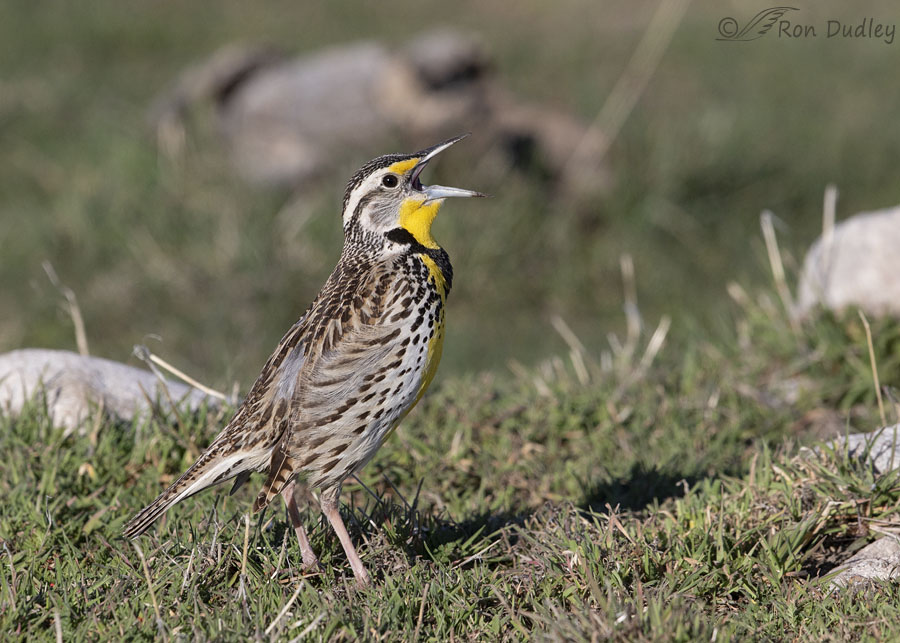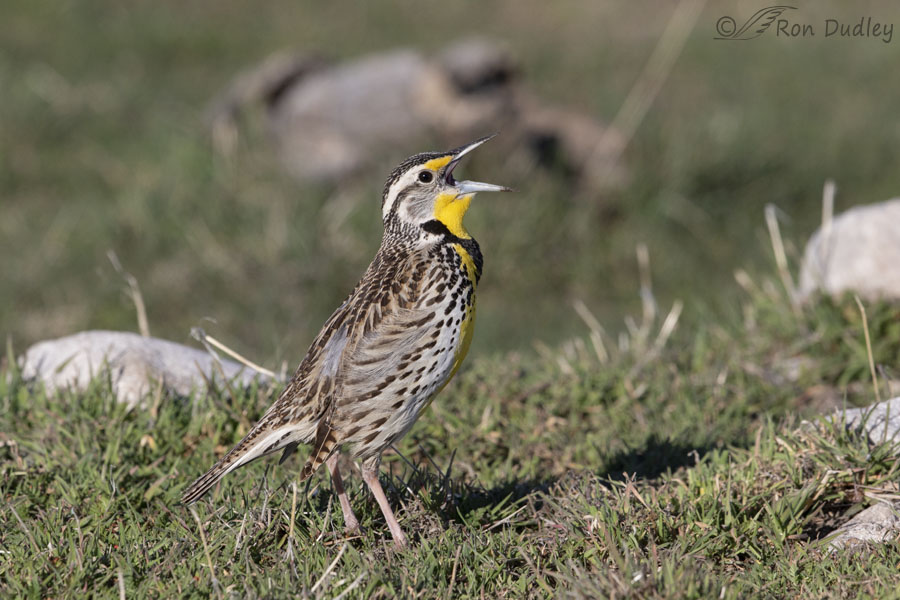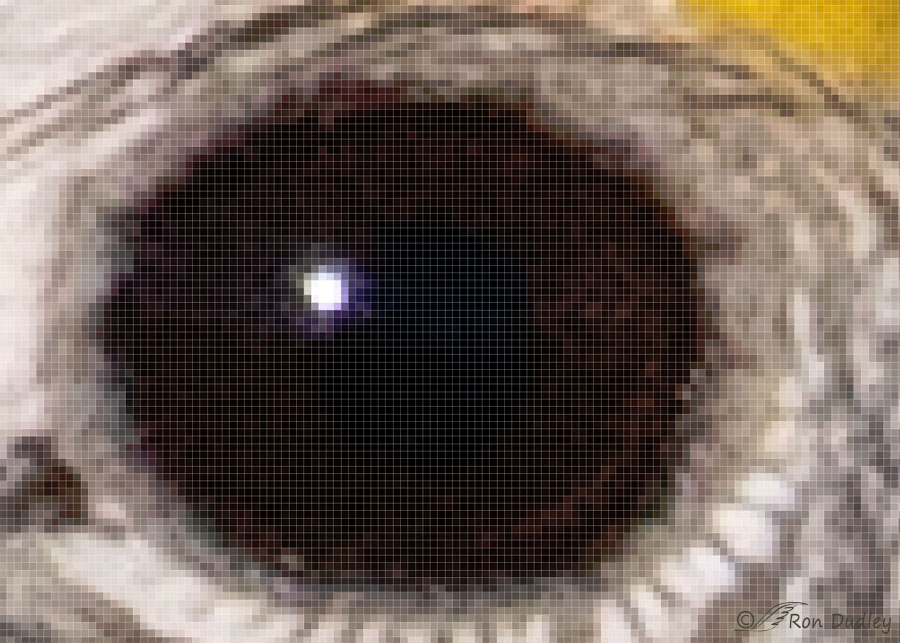And my attempt to explain, and demonstrate, some of the effects of resolution on digital images.

1/2500, f/7.1, ISO 500, Canon 7D Mark II, Canon EF 500mm f/4L IS II USM, not baited, set up or called in
For me there’s lots to like about an image like this one. I caught a nice singing pose, the meadowlark is in typical natural habitat for the species, I have a catch light in the eye, the bird is large in the frame and sharp – so sharp I chose to reduce my normal amount of sharpening during processing by 50%.
Lots of folks seem to be confused by what is meant by ‘resolution’ in digital photography. For example, I get many requests for image use for educational or conservation purposes. I’ll sometimes approve those requests (often requiring a reasonable licensing fee, depending on the situation) with the caveat that they can use the low resolution version of the image I have on my blog but I will not send them a high resolution version of the image. Not ever. And they don’t understand why.
So I thought this image would be an excellent candidate to use in an attempt to explain why. I’m going to use the catch light in the eye of this meadowlark to actually show the difference in resolution between the low res photo above and a high res version of the same photo.
Resolution can be defined in several ways. One definition is “how many pixels are displayed per inch of an image” and another is “how much detail an image holds”. I’m going to try to demonstrate below what those words mean in the real world.

For reference, this is the uncropped, full frame version of the photo above. As you can see I cropped it very little by taking a thin slice off the left in order to make the bird slightly less centered.
![]()
When I post photos to my blog they’re always resized to only 900 pixels on the long side. At that size this is what the catch light in the eye of the meadowlark looks like when I enlarge it. Each tiny square is a single pixel so at this size the catch light consists of only 4 pixels. Those 4 pixels of varying shades of gray contain very little detail but the entire image looks just fine at this small size (about 9.25″ wide on a full sized screen).
Printed or seen any larger than that and the low res image would look pixelated (another way of saying terrible). That’s why I feel relatively safe posting my images to my blog at only 900 pixels on the long side. If someone swiped an image that size, even an 8×10 print wouldn’t look good and anything larger would look progressively worse.
But what about a high resolution version of the same image?

Here’s the same photo showing the meadowlark’s catch light at full resolution. Each pixel appears smaller and the eye is larger because there are so many pixels involved I had to zoom in closer to make each pixel large enough to be easily seen.
In the low res version of the image the catch light consisted of only four pixels but in this high res version it consists of approximately 82 pixels of varying shades and colors (I counted them by zooming in even tighter). Obviously there’s much more detail (more pixels) in this catch light than in the low res version. If stolen the high res version of the entire image could be printed huge and still look very good.
So if you aren’t a reputable publisher please don’t ask me for a high res version of one of my images, even if it’s for a cause I support like education or conservation. The answer will always be no because that’s the easiest way I know of to lose control of my own images..
Ron
Notes:
Here’s a related way of explaining resolution using this same image:
- The low res version of the cropped image is 900 x 643 pixels so the entire image contains 578,700 pixels.
- The high res version of the cropped image is 5013 x 3581 pixels so the entire image contains 17,951,553 pixels. There’s 31 times more detail in the high res version than in the low res version.
When I get print requests that I approve I have them printed locally and then shipped to the client. And yes, I trust my printer.
I certainly hope all my regular readers and commenters realize that I don’t worry about them swiping images. It’s only a certain percentage of the thousands of other folks who see my blog that I need to worry about.


Fun illustration, Ron. As an artist, I’m always trying to see detail and understand how something that looks to be one color is really made up of many different colors and shades. The last image illustrates that just perfectly. Now if I could only blow up what I see in real life so I could understand the components!
Singing its heart out. Beautiful! Thanks, Ron.
Thank you, Ellen.
Your tutorial is very much appreciated, as is the singing Meadowlark.
Admittedly, I’m showing my ignorance by asking these questions, so feel free to just say “it’s complicated”
If photos 900 pixels on a side are 9.25″ wide on (your) full sized screen, what is the size on the screen of your hi res photos?
When you have photo’s printed, are they printed at high res?
No problem answering your questions, Lyle.
When images are displayed on a screen that is smaller than the native size of the image many programs resize the images to fit on that particular screen. When they aren’t resized you only see part of the image on the screen. You’ve probably seen that happen when folks send you huge images in emails – you have to scroll around to see the entire image.
Yes, I always send my images to my printer at 300 dpi and full res. Their printing algorithms make them fit to the requested print size in a way I don’t understand.
Ron,
Thanks, nice demo.
Stephen
Thanks, Stephen.
Ron – So interesting, both the technical and the ethical aspects of your art.
On the ethical side, this is a great addition to your post of Friday, 10/8, in which you lament the lack of respect of the photographer intruding on the burrowing owl. Because of your great comments, I now wonder, each time I look at an amazing nature photo, “Was this achieved in an ethical manner?”
Thanks for the enlightenment!
“I now wonder, each time I look at an amazing nature photo”
I do the same thing, Carolyn. Well not “every time” but in certain types of nature photos I know that unethical practices are often used so those photos make me wonder. And the chances of a photo being taken unethically go up astronomically when I see the names of certain photographers attached to the photo.
Thank you. As always.
I did understand but what a beautiful way to illustrate your point.
Thanks very much, EC.
Great demo and shows what I try to explain to people about resolution and magnification. Raptors (and swifts, swallows and many other birds) don’t see a greatly enlarged image. Magnification only makes the same amount of sharpness/blurriness larger, not clearer. They have greatly increased resolution. In the sharp portion of our retina (macula or fovea) we have approximately 200,000 cones per square millimeter. (Cones are responsible for color and sharpness). A hawk or a swallow has over a million. Those small lines of a bar code on a package quickly blur together for us as you get further away from them. The birds don’t see them bigger but they still can distinguish individual lines. This is only a tiny part of what makes bird vision so incredibly remarkable and superior to our vision.
Thank you, Dan, for this explanation!
Dan, I love your use of bar codes as a teaching tool for avian sight resolution. Just an excellent way of getting your point across and coming up with it is a sign of a great teacher.
Thx! Excellent explanation that’s VERY relateable….
Such a happy and colorful meadowlark! Something about birds with yellow feathers – always brings a smile! The internet is amazing and has changed the world. And in many ways not great such as image thievery.
Thanks, Kathleen. I’m beginning wonder if more bad things have resulted from the internet than good, even when I don’t include image theft.
So true – don’t get me started on the abundance of porn, human trafficking and the dumbing down of society all via the internet. My current nerd obsession (soap box) – the disappearing adverb in American english. BTW – it’s a beautiful day outside isn’t it? 🙂
LOL 🙂
Very interesting and great post!!
Have a GREAT Holiday!!
Thanks, Dick.
A packed post. A beautiful picture of a joyous bird (one hopes), a crystal clear and appreciated explanation of resolution and pixels and then to bring us back to earth a reminder of our tendency to pilfer. As well as anthropomorphize. Thank you Ron.
“our tendency to pilfer”
Frances, I hope all my regular readers and commenters realize that I don’t think they have a tendency to pilfer. It’s only a certain percentage of the other folks who see my blog that I need to worry about. I’m going to add a note to that effect to the bottom of this post.
It’s absolutely mind blowing how much image theft goes on out there.
Sorry if I offended people. I certainly do not think that your regulars pilfer. I was being hyperbolic or simplistic by using “us” to refer to humanity in general- which as we all seem to agree can have unpleasant traits.
Frances, I’m sure no one was offended by what you said. I think we knew what you meant and what you didn’t mean. I certainly did.
I just wanted to make sure that what I said in my post wasn’t misinterpreted.
Excellent means of some control against thieves that I wouldn’t have thought about. 🙂 DO understand resolution but never would have thought of it in those terms. THX!
“Excellent means of some control against thieves”
“Some” control is right, Judy. But it’s far better than no control at all.
And the Meadowlark sings on! Happily oblivious to pixels and licensing rights. We should all be so lucky.
This is a very cheerful picture. A good way to start the morning.
Thanks, Porcupine. I’m very fond of the photo for quite a few reasons.